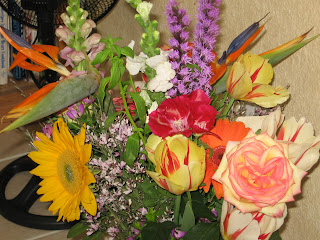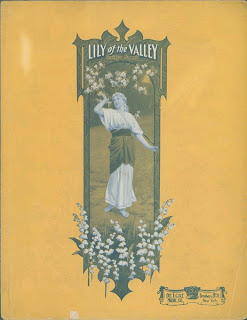Today I am starting a series of blogs about the Meanings of Flowers.
The Victorians were probably the very best
at using flowers as symbols.
A little nosegay sent to a lady was actually a letter!
WaltDisneyWorld, Epcot, Great Britain country around the lake.
When researching the Language of Flowers,
I discovered that one flower
may have several different meanings!
Sometimes they are opposite of each other!!
I will be compiling together from different sources,
but if in doubt, I will lean heavily on
Kate Greenaway's Meaning of Flowers book.
She has delightful drawings,
if you are not acquainted with her work.
She was the most popular illustrator
of Victorian time.
She was the most popular illustrator
of Victorian time.
I am also a complete crazy fan for
Cicely Mary Barker's work.
She painted adorable fairies,
with clothes to match the flower,
tree or plant she was illustrating.
Here is an official web site
for all things Cicely Mary Barker:
from efairies.com
Now, I ask myself, where to begin?
some of the flowers sent to me when I was in the hospital last year
If I start with "A", it could be a loooong time.
Start with Flowers of the Month?
Start with Birthday flowers?
Well, let's just jump in!
The Victorian Language of Flowers
Although the legendary associations and religious meanings of flower symbolism have existed for centuries, the use of the symbolic meaning of flowers to represent emotions was developed to a high degree during Victorian times. Due to the strict protocol of the times, emotions, wishes and thoughts were not openly expressed between men and women. Instead, an elaborate language based on flower symbolism was developed. Gifts of either single flowers or bouquets conveyed clear messages to the recipient.
During the Victorian era, flowers adorned nearly everything--hair, clothing, jewelry, home decor, china plates, stationary, wallpaper, furniture and more. Even the scents of flowers had their own meanings in the language of flowers. For example, a scented handkerchief might be given in place of actual flowers.
With the increasing complexity of flower symbolism, handbooks were written to guide the understanding of the symbolic meaning of flowers. The first book written on flower symbolism in modern times was Le Language des Fleurs by Madame Charlotte de la Tour in 1819. The most popular book on flower symbolism, which remains a prominent resource today, is Kate Greenaway's Language of Flowers (1884).
from the Society of American Florists
Kate Greenaway "Let's go a may-poling"
MAY - Lily - according to TeleFlora :
vintage song sheet, unknown date
by Pacon, not sure where on the internet.If you know, please update me.
teleflora bouquet of lilies and roses
Let's have some crochet fun:

Can't get blogspot to put the directions in the right place.
They remain, stubbornly, at the end of this blog!

Can't get blogspot to put the directions in the right place.
They remain, stubbornly, at the end of this blog!
Cicely Mary Barker
Sweetest of the flower Lily of the Valley
"Sweetest of the flowers a-blooming
In the fragrant vernal days
Is the Lily of the Valley
With its soft, retiring ways.Well, you chose this humble blossom
As the nurse’s emblem flower,
Who grows more like her ideal
Every day and every hour.
Like the Lily of the Valley
In her honesty and worth,
Ah, she blooms in truth and virtue
In the quiet nooks of earth."
There is more to this poem, comparing a nurse to the Lily of the Valley.
In the fragrant vernal days
Is the Lily of the Valley
With its soft, retiring ways.Well, you chose this humble blossom
As the nurse’s emblem flower,
Who grows more like her ideal
Every day and every hour.
Like the Lily of the Valley
In her honesty and worth,
Ah, she blooms in truth and virtue
In the quiet nooks of earth."
There is more to this poem, comparing a nurse to the Lily of the Valley.
You can find it here:
I was unable to find the author.
Can anyone help me?
Here is a dress by Liana:
This one will fit her Paper Boutique doll:
a sweet baby fairy with lilies:
Little baby fairy, what did you find?
painting and calligraphy
by Susan Loy
"This is the day which the Lord hath made;
we will rejoice and be glad in it.." Psalms 118:
This verse from Psalms expresses each day's promise of a return of happiness and a reason to rejoice. Psalms are songs and are among the most poetic verses in the Bible.
The lily of the valley means return of happiness in the Victorian language of flowers. In North American and British flower of the month traditions, it is the flower of May and has been called May lily. Its botanical name is Convallaria majalis, from convallis, valley, and majalis, May. Native to Europe, Asia, and parts of North America, it is prized for its fragrance as well as its beauty.
found at Activityvillage.co.uk
found at supercoloring.com
by Anna Miller
courtesy of Indygo Junction
I hope you have enjoyed today's flower:
Lily of the valley,
flower for the month of May.
inkspired
39. Lily of the Valley Afghan
Materials: Worsted Weight Yarn; Black (B) 36 oz and Grass Green (G) 3 oz. Sport Weight Yarn; White (W) 2 oz. Yarn Needle. Maggie used Black Crochet Cotton and a Large sewing needle to applique leaves and stems.
Crochet Hook: J-10 (6 mm) or size needed to obtain gauge. I-9 (5.5 mm) for Border, and Leaves. F-5 (3.75 mm) for Bells
Gauge: J Hook: 7 rows = 4”; 3dc = 1”
Special Stitches: V-st: Dc, ch 2, dc.
Picot V-st: Dc, ch 4, sl st in 3rd ch from hook, ch 1, dc.
Side Panels: (Make 2)
With B and J hook, ch 43.
Row 1: Dc in 4th ch from Hook and in ea ch across. CH 3, TURN EACH ROW. (41 dc)
Rows 2-33: Dc in each st across.
Row 34: Skip 1 st, * V-st in next st, skip 2 sts, rep from * across, skip 1 st, dc in end st. (13 V-sts)
Rows 35-66: V-st in each V-st across, dc in last st.
Row 67: Dc in each ch-2 sp and dc across. (41 dc)
Rows 68-99: Dc in each st across. At end of Row 99, finish off.
Center Panel: ( Make 1)
With B and J hook, ch 43.
Row 1: V-st in 5th ch from hook, * skip 2 ch, V-st in next ch, rep from * across, skip 1 ch, dc in end ch. CH 3, TURN EACH ROW.
Rows 2-33: Rep Rows 35-66 of Side Panel.
Rows 34: Rep Row 67.
Rows 35-66: Dc in each st across.
Row 67: Rep Row 34 of Side Panel.
Rows 68-99: Rep Rows 35-66 of Side Panel. At end of Row 99, finish off.
Finishing: With right sides together, with yarn needle and black yarn, sew sides of panels together making sure V-sts face up.
Border:
Rnd 1: Using I hook, join B, in any st, ch 3, being careful to keep work flat dc around outside of afghan working (2 dc, ch 2, 2 dc) in each corner; join with sl st in 3rd ch of beg ch-3. DO NOT TURN EACH RND.
Rnd 2: Ch 3, dc in each st around working (2 dc, ch 2, 2 dc) in each corner; join with sl st in 3rd ch of beg ch-3.
Rnd 3: Ch 5, dc in same st as joining, * skip 2 sts, V-st in next st, rep from * around working (V-st, ch 2, V-st) in each corner; join with sl st in 3rd ch of beg ch-5.
Rnd 4: Sl st in ch-2 sp (center of V-st), ch 7, sl st in 3rd ch from hook, ch 1, dc in same sp, * picot V-st in each V-st to corner, work (Picot V-st, ch 2, Picot V-st) in corner ch-2 sp, rep from * around; join with sl st in 3rd ch of beg ch-7. Finish off.
Leaves: ( Make 10)
With G, using I hook, ch 30.
Rnd 1: Dc in 4th ch from hook and in each ch to within last 6 ch, sc in each of next 5 ch, (sc, ch 2, sc) in end ch (this is tip of leaf), around other side; sc in each of next 5 ch, dc in each ch to end, sc across base of leaf to 3rd ch of beg ch-3. Ch 3, DO NOT TURN.
Rnd 2: Dc in each st across to within 3 sts before tip, hdc in next st, sc in each of next 2 sts, (2 sc, ch 3, sl st in first ch, 2 sc) in
ch-2 sp, around other side; sc in each of next 2 sts, hdc in next st, dc in each st to end. Finish off. Weave in ends.
Stems: (Make 10)
With G, using J hook, ch 40. Finish off. Weave in ends.
Bells: (Make 30)
With F hook and W, leaving an 8" long end on starting ch, ch 2.
Rnd 1 (right side): 6 Sc in 2nd ch from hook. Do not join. Mark ends of each rnd.
Rnd 2: Work 2 sc in each st around.
Rnd 3-5: Sc in each st around.
Rnd 6: Sl st in next st, * ch 4, sl st in first ch, skip 1 st, sl st in next st, rep from * around. (6 points) Finish off. Weave in end.
Pull long end through to right side, center top of bell. Tighten starting ch.
Finishing: Center and sew leaves and stems in place using large sewing needle and black thread.
Using long end, sew bells onto stem leaving a 1” length of yarn on the right side for bells to hang.
MaggiesCrochet.com - Order Toll Free 1-888-454-2101
from 40 Free Crochet Patterns
vintage line drawing


























No comments:
Post a Comment